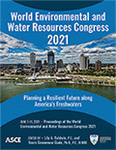Assessing Flow Rate through a Lake Siphon System via Computational Flow Modeling
Publication: World Environmental and Water Resources Congress 2021
ABSTRACT
Siphons are often used to release excess water from impoundments such as lakes. They eliminate the use of pumps, which save energy and provide consistent water level control. However, it is often difficult to determine the actual flow rate at different stages of a siphon cycle. Field condition, storm type, and design criteria play critical roles in major and minor loss components of an active siphon system. A calibrated model thus can be useful to evaluate the performance of a siphon. Therefore, the objective of this study is to estimate the flow rate through a lake siphon system via three-dimensional modeling. Spencer Creek Lake in West Tennessee is chosen for this study, which is monitored by a water level sensor at the lake and another near the siphon outlet. The lake level data are simulated in the Ansys-Fluent package for steady flow conditions at various stages of the siphon operation. It reveals the associated flow physics of the siphon operation. Therefore, sources of loss at different sections of the siphon system can be identified to correlate with the discharge. Finally, the predicted outlet discharge is compared to the flow rate at the outlet channel. The successful calibration of the siphon system would allow the lake operators to estimate siphon release at different stages of an active siphon cycle and provide the knowledge to design more effective siphons for other lakes in West Tennessee.
Get full access to this article
View all available purchase options and get full access to this chapter.
REFERENCES
Ahmed, W., Li, S., and Ramamurthy, A. (2019). “Characteristics of flow over the crest of a siphon spillway.” CSCE Annual Conference.
Ahmed, W., Li, S., and Ramamurthy, A. (2018). “Investigation of Discharge Coefficient for Siphon Spillway.” CSCE Annual Conference.
Babaeyan-Koopaei, K., Valentine, E., and Ervine, D. A. (2002). “Case Study on Hydraulic Performance of Brent Reservoir Siphon Spillway.” J. Hydraul. Eng., 128(6), 562-567.
Bhuyian, M. N., and Kalyanapu, A. (2018). “Accounting Digital Elevation Uncertainty for Flood Consequence Assessment.” Journal of Flood Risk Management, 11, S1051-S1062.
Duncan, W., Huntley, C., Hokenstrom, J., Cudworth, A., and McDaniel, T. (1987). Design of Small Dams. A Water Resources Technical Publication.
Ervine, D., and Oliver, G. (1980). “The Full-Scale Behaviour of Air-Regulated Siphon Spillways.” Proceedings of the Institution of Civil Engineers, 69(3), 687-706.
Ervine, D. (1976). “The Design and Modelling of Air-Regulated Siphon Spillways.” Proceedings of the Institution of Civil Engineers, 61(2), 383-400.
Ghafourian, A., and Adlin, M. (2012). “Discharge Coefficient in Siphon Spillway with Different Cross Sections.” World Applied Sciences Journal, 17(2), 163-167.
Tadayon, R., and Ramamurthy, A. S. (2013). “Discharge Coefficient for Siphon Spillways.” J. Irrig. Drain. Eng., 139(3), 267-270.
Tao, Y., Li, C., Min, X., and Min, Z. (2012). “Siphon Pipeline Resistance Characteristic Research.” Procedia Engineering, 28, 99-104.
Te Chow, V. (1959). Open-Channel Hydraulics, McGraw-Hill New York.
Information & Authors
Information
Published In
Copyright
© 2021 American Society of Civil Engineers.
History
Published online: Jun 3, 2021
Authors
Metrics & Citations
Metrics
Citations
Download citation
If you have the appropriate software installed, you can download article citation data to the citation manager of your choice. Simply select your manager software from the list below and click Download.
